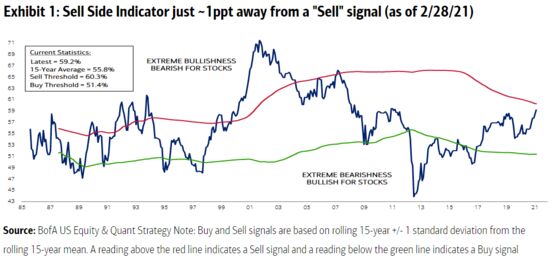Wall Street Bullishness Is Becoming a Contrarian Sell Signal
Wall Street Bullishness Close to Flashing Contrarian Sell Signal
(Bloomberg) -- Stock market optimism among Wall Street strategists has risen close to levels that signaled trouble for equities in the past.
A Bank of America measure of their bullishness is near a level that historically has been bearish for stocks. The gauge assesses the average recommended allocation to equities by sell-side strategists and is very close to triggering a sell signal, a team including Savita Subramanian wrote Monday.
“The last time the indicator was this close to ‘Sell’ was June 2007 after which we generally saw 12-month returns of minus 13%,” the strategists said, adding even current levels signal below-average equity returns over the next year. “We‘ve found Wall Street bullishness to be a reliable contrarian indicator.”

Last week’s worries about the impact of higher bond yields on stocks evaporated Monday, with U.S. equities notching their biggest advance since June. Optimism is evident from the record amount of cash poured into stock ETFs in February as investors bet additional fiscal stimulus and the Covid-19 vaccine rollout will supercharge growth.
The S&P 500 is up about 4% so far this year and some 32% over the last 12 months. The Bank of America gauge rose nearly 1 point to 59.2% in February.
“The current level is forecasting 12-month returns of just 7%, a much weaker outlook compared to an average 12-month forecast of 16% since the end of the Global Financial Crisis,” the BofA team wrote.
While investors seem to have come to terms with the recent upheaval in bond markets for now, an ongoing shakeout could spark fresh angst, particularly if real yields keep rising.

The correlation between U.S. equities and inflation-adjusted Treasury yields dropped to the most negative in five years last week, according to data compiled by Bloomberg. That suggests further increases in real yields could hurt the S&P 500 index.
©2021 Bloomberg L.P.